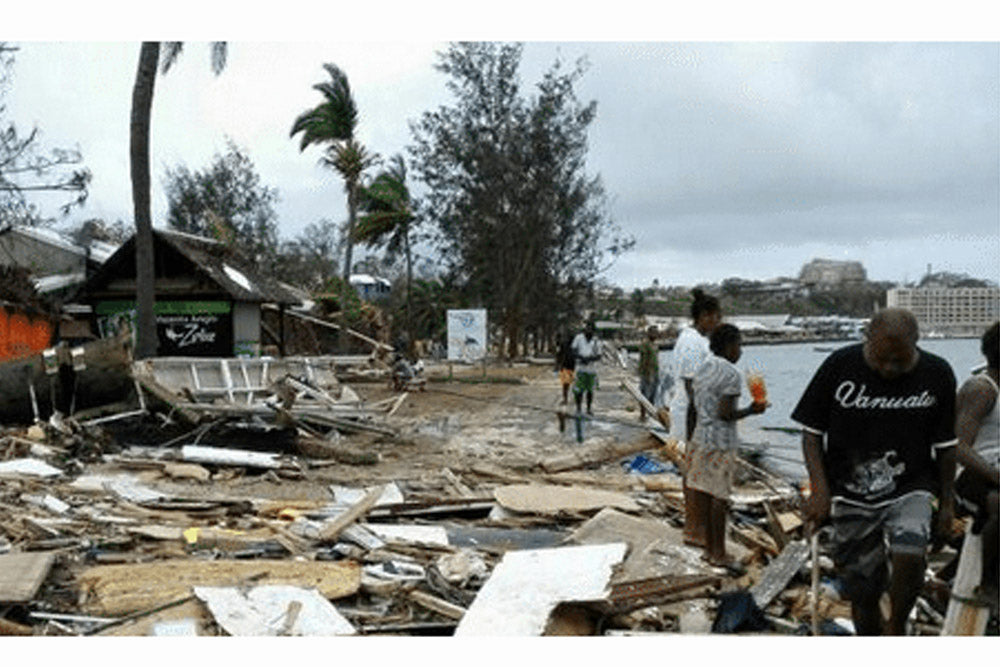
Earlier this year on March 13, Cyclone Pam, a category 5 storm, hit Vanuatu, affecting the lives of over 188,000 people and leaving 11 dead. Shortly after the devastating storm hit, Vanuatu’s president made an international appeal for support to help the small island nation recover.
At the time it’s estimated that the homes of over 90,000 families were in need of repair, and nearly 110,000 people were without safe drinking water. On many of the islands, sanitation structures were badly damaged or destroyed, leaving communities without the most basic of needs.
Over 95 percent of the agricultural sector was destroyed, a devastating hit for nation whose population is highly reliant on subsistence farming and crop exports for food security and livelihoods.
In response to this massive crisis, the Vanuatu government teamed with humanitarian agencies from across the globe to orchestrate a massive emergency aid operation.
Here at Bula Kava House, we tried to do our part to help the people of Vanuatu by raising $1,067 online and $150 at the Portland Kava Bar. We contributed $650 to the pool that brought the total to $1,867 in donations. A number that far surpassed our goal! We split our donation between Oxfam and UNICEF.
While the initial shock of Cyclone Pam may have passed, the recovery efforts in Vanuatu continue still to this day.
Tourism on the Rebound
Vanuatu is heavily dependent on tourism to sustain its national economy, and many hotels and cabanas have reopened their doors so that tourist can begin to once again enjoy the splendor of these majestic islands. But more work still remains.
After a long and intense rebuilding period, Vanuatu has successfully reopened all but five of the island’s largest hotels. The country’s second most popular resort island, Espiritu Santo, was largely unaffected by the storm, and remains a premiere destination for Australian tourists.
Vanuatu Prime Minister, Sato Kilman, has stated in recent weeks that the majority of the country’s schools and hospitals are also back up and running in addition to the resort facilities. The Prime Minister has urged citizens of the world to consider Vanuatu’s doors once again open, and wanted to empathize that in order for the country to continue to make a speedy recovery, it needs tourists to come and visit.
But while the country’s tourism trade has bounced back, many living in smaller communities still face an uphill climb, especially in the face of future hazardous weather.
Global Warming in the South Pacific
For those living within the South Pacific, the growing threat of climate change has been one that many have seen coming.
In a recent address to the United Nations, the President Anote Tong of nearby Kiribati, also impacted by Cyclone Pam, warned the world about the impending risks island nations in the region expected to face due to global warming.
“For leaders of low-lying island atolls, the hazards of global warming affect our people in different ways, and it is a catastrophe that impinges on our rights…and our survival into the future,” said President Tong in front of a U.N. assembly. “There will be a time when the waters will not recede.”
The reality is that disaster like Cyclone Pam was predicted. Earlier this year, Port Vila, the capital and largest city in Vanuatu, was named the most at risk city in the world to natural disasters by Verisk Maplecroft, an independent risk assessment firm. Eight other cities listed in the Verisk’s top 10 were located in the Philippines, another nation made of mostly sea-level islands. It’s unsurprising then that Pacific Island leaders would be at the forefront in calling for action on climate change in recent years, attributing the rising sea levels and intensified storms that endanger their countries to global warming.
Additionally, many of Vanuatu’s homes are constructed using flimsy materials vulnerable to floods and storms, according to UNICEF. When massive storms do hit, the nation’s infrastructure is unable to cope, leaving many homes and buildings in rubble.
While scientists cannot say for certain whether climate change will lead to a greater number of cyclones, they say one thing is clear: those storms that the world does see are likely to be stronger and more destructive than ever before.
This type of threat is one that the people of Vanuatu and millions of other living in coastal or low-lying areas will face in the future. Millions more in other parts of the world will begin to experience increased flooding, drought and other hazards.
A 2013 report from the Overseas Development Institute found that “climate change and exposure to ‘natural’ disaster threaten to derail international efforts to eradicate poverty by 2030.” The same study also found that by 2030 “up to 325 million extremely poor people will be living in the 49 most hazard-prone countries in the word.”
The poor people in the world are also the ones most affected by disasters. While world leaders have sought for solutions, international plans like the Hyogo Framework have largely failed to keep up with the growing number of natural disasters the world has seen in recent years.
The reality of the situation remains: that unless dramatic action is taken the challenge of climate-driven poverty, inequality and natural disasters is likely to become dramatically worse.
